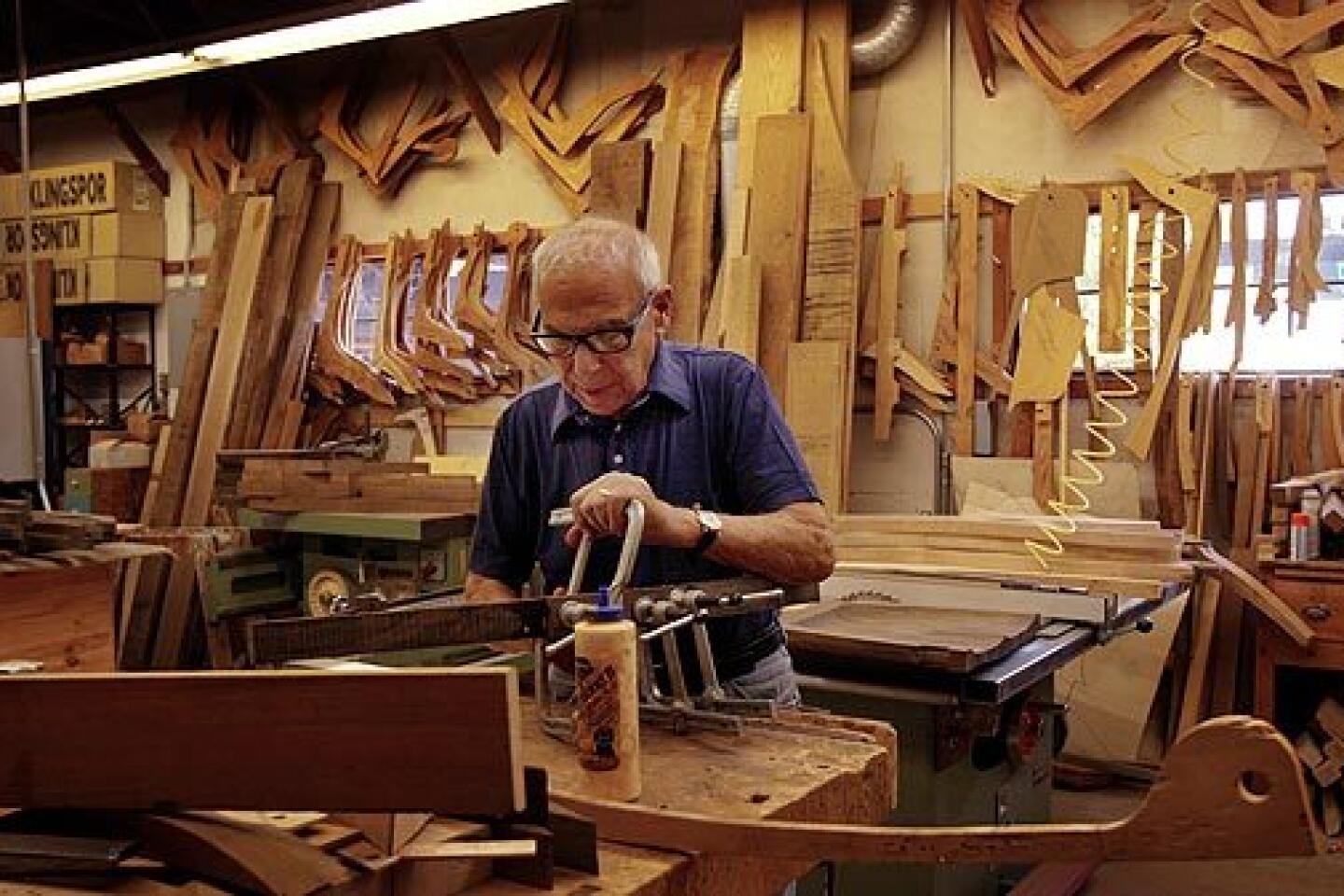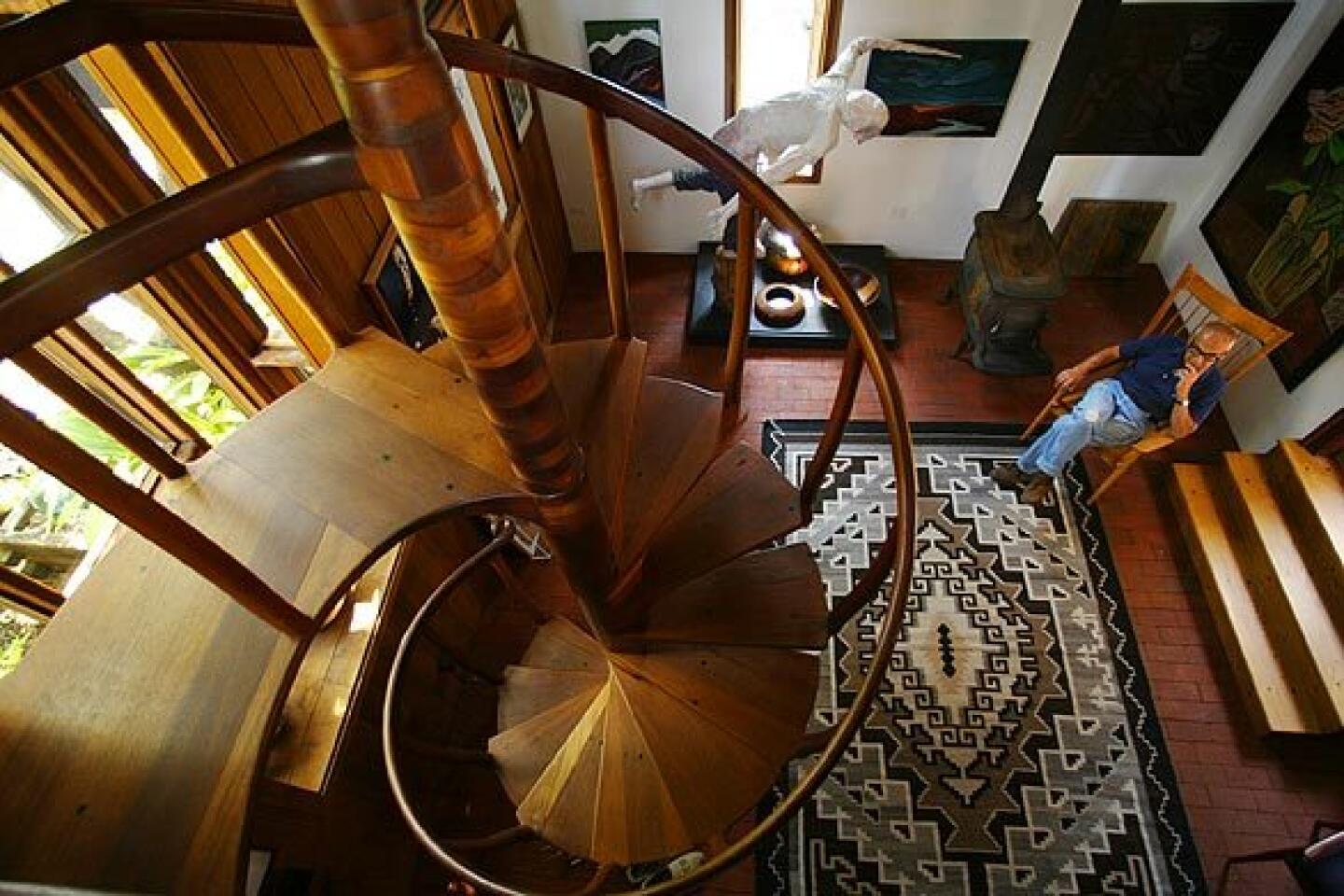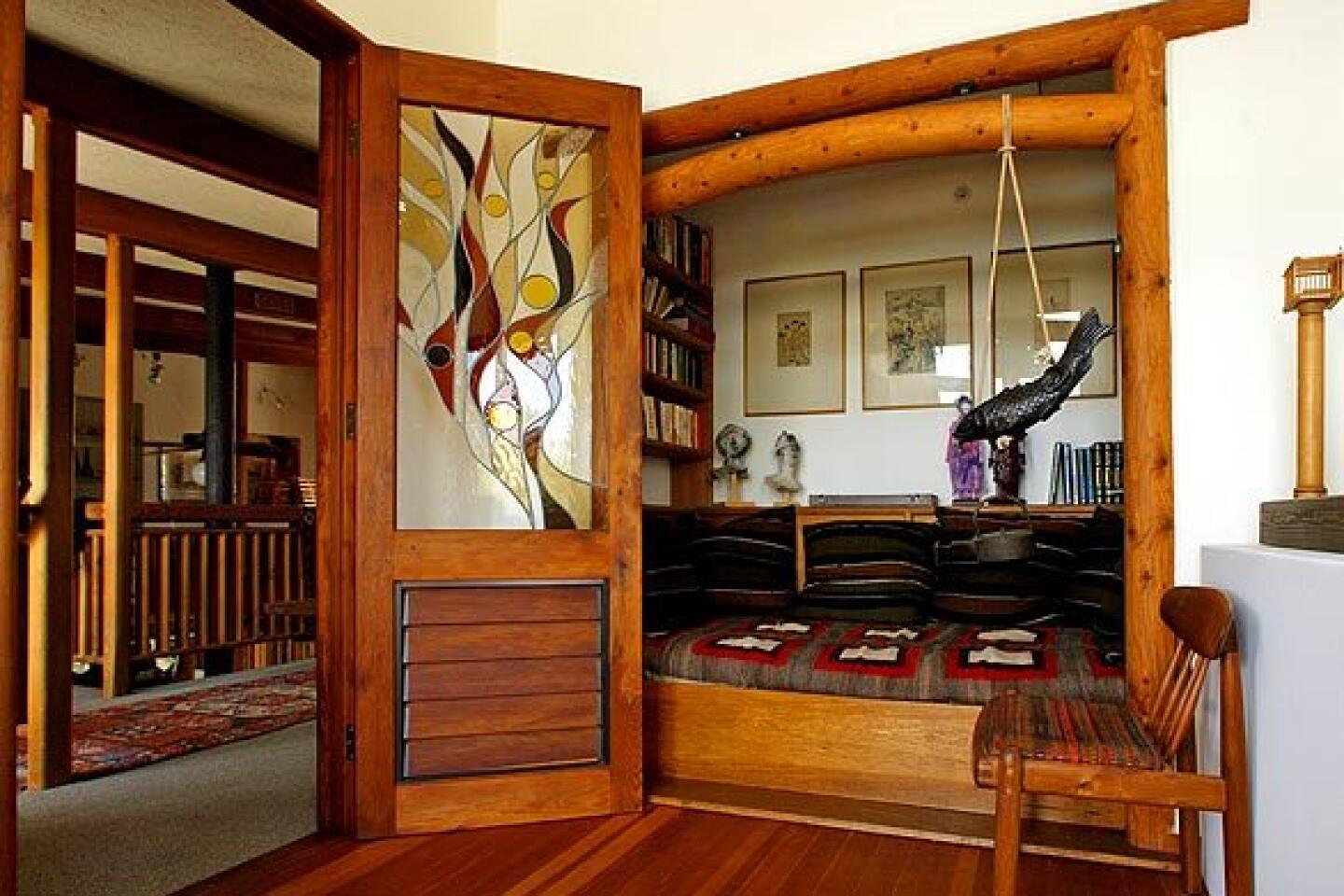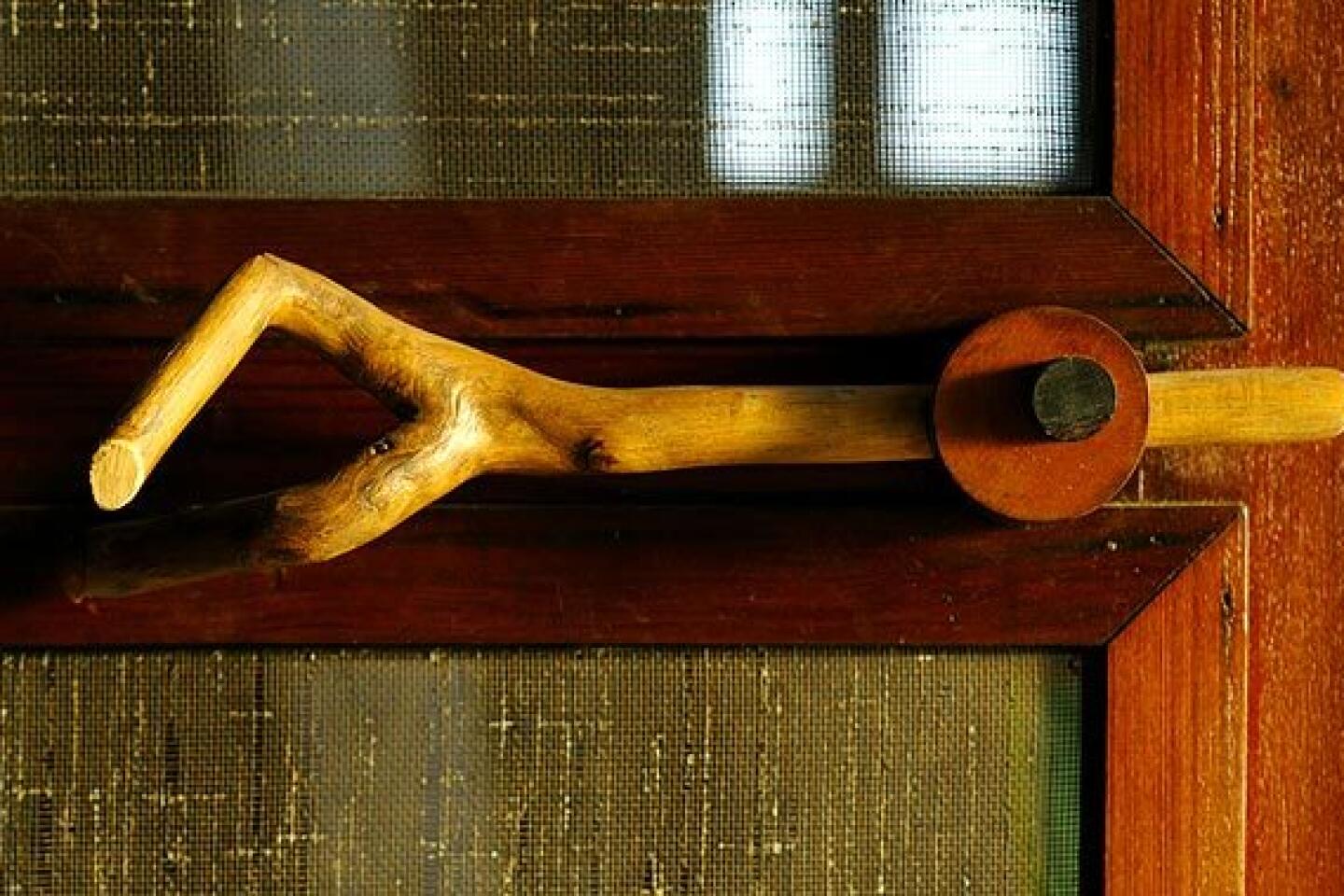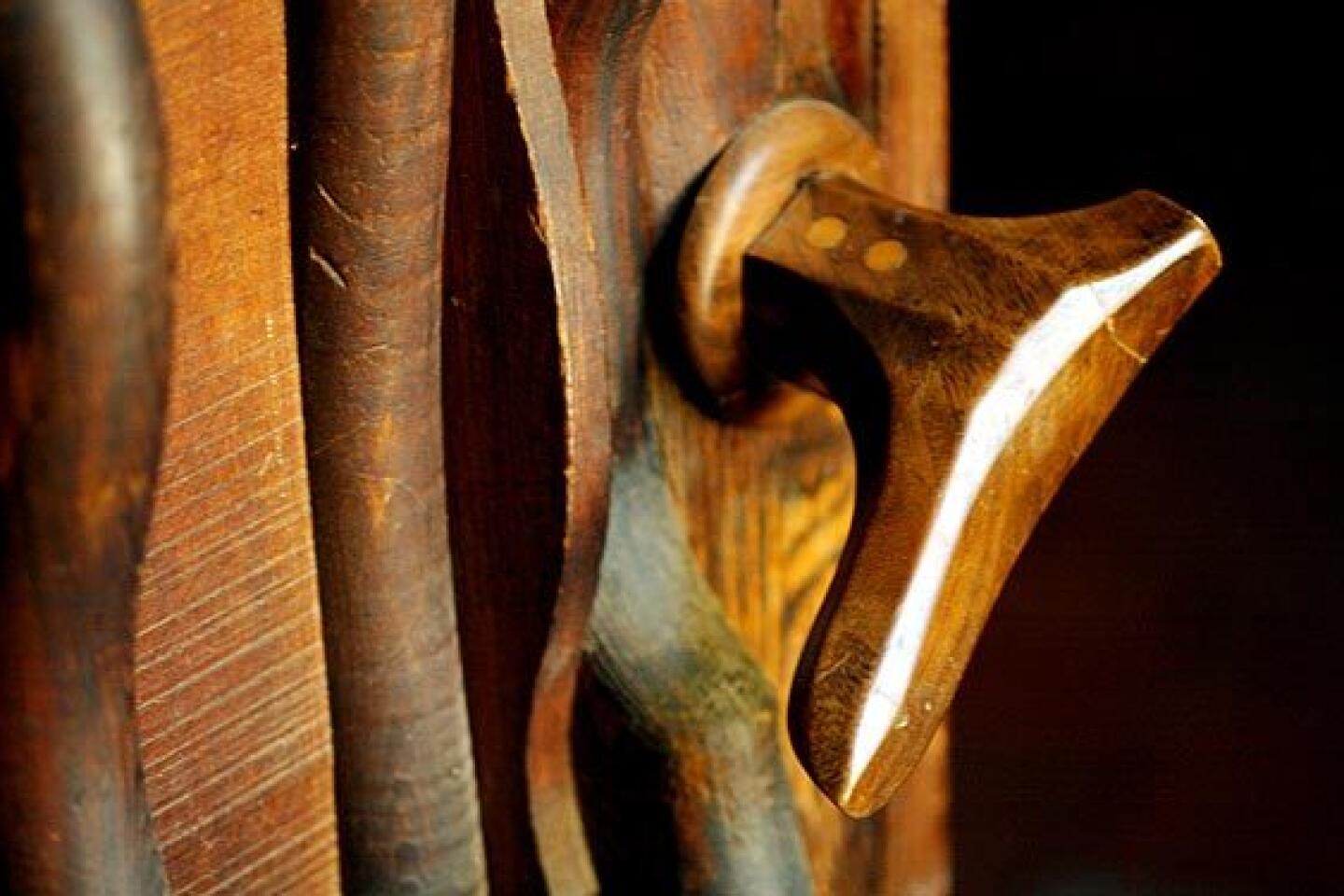Sam Maloof dies at 93; designer and builder of simple, beautiful furniture
Sam Maloof, a designer and woodworker whose furniture was initially prized for its simplicity and practicality by Southern Californian homeowners in the 1950s and later valued for its beauty and timelessness by collectors, museum curators and U.S. presidents, has died. He was 93.
Maloof died Thursday at his home in the Alta Loma section of Rancho Cucamonga, his longtime business manager Roz Bock confirmed. No further details were given.
Maloof, whose career began six decades ago just as the American modernism movement was becoming popular, put usefulness before artistry and turned down multimillion-dollar offers to mass-produce his original designs. He worked out of his home workshop, shaping hardwood, one part at a time, into rocking chairs, cradles and hutches that were shorn of unnecessary adornments.
His hi-fi cabinets, cork-top coffee tables and other modern pieces were instantly praised by home magazine editors and trend-setting interior designers. His walnut chairs and bar stools were installed in several of the so-called Case Study Houses -- the modernist, experimental homes in the Los Angeles area built between 1945 and 1966 by Richard Neutra, Charles Eames, Eero Saarinen and other progressive architects.
Even after Maloof was recognized as an influential pioneer of contemporary California decor, and even as his furniture was reselling for 100 times its original price, Maloof referred to himself simply as a âwoodworker.â
âHe was trying to make other people appreciate what it was like to live with a handcrafted object in which there was a kind of union between maker, object and owner,â said Jeremy Adamson, who wrote âThe Furniture of Sam Maloof,â published in 2001 to coincide with a retrospective exhibition of Maloofâs work at the Smithsonian American Art Museumâs Renwick Gallery in Washington, D.C.
President Carter, a woodwork hobbyist and friend who visited Maloofâs home, signed a photograph âto my woodworking hero.â
Carter and subsequent presidents used Maloofâs signature rocking chairs in the White House. Elongated rockers on the chairs look sculptural, like an archerâs bow, but they were made for a very practical reason: to keep the chairs from tipping over.
The seventh of nine children born to Lebanese immigrants, Maloof in 1985 became the first craftsman to receive a MacArthur Foundation grant. His designs could not be categorized as Arts and Crafts, modern, Scandinavian or Italian. The self-taught designer would select a piece of wood -- walnut was his favorite because of its texture and durability -- and cut out parts freehand on a band saw.
Instead of following plans, he matched an image in his head. He refined the shape with hand tools to make the finished piece of furniture comfortable, functional and beautiful. He carefully considered the appearance of every angle of the piece, even chair backs and cabinet interiors, as well as grain pattern and his innovative joinery.
Pieces were assembled without nails or metal hardware. Even hinges and underbracing were wood. Once, to test the strength of the joints for a set of chairs, he made a prototype and dropped it from the roof of his garage onto his driveway. The joints survived.
Maloofâs modern furniture fit handsomely in the post-and-beam dwellings blanketing new suburbs after World War II. In the postwar housing boom, the wood, leather, cork and other natural materials he used softened the hard edges of emerging minimalist architecture.
âTaut and muscular and yet most elegantâ is how Jonathan Leo Fairbanks, curator emeritus of American decorative sculpture for Bostonâs Museum of Fine Arts, described Maloofâs furniture in 2002.
Later, Fairbanks told a Times reporter: âHe is mighty generous with his time and talent in many ways. Sam is drenched with more humanity or love of humanity and out-flowing generosity than can be found in a dozen other people. Donât you sense this âsoulâ in his works?â
Singer Ray Charles also felt Maloofâs presence in his work.
âRay Charles couldnât see my furniture,â Maloof told a reporter. âBut he said he could feel that it had soul. When he asked about my rocker [at a friendâs house], his host told him, âThatâs a chair made by Sam Maloof.â Ray ran his hands over the wood shouting, âI know this man! I know this man!â On his next visit, the first thing Ray Charles said was, âIâd like to touch that furniture again that Sam Maloof made.â â
Maloof was a tireless lecturer at gallery exhibits, woodworking shows and crafts contests. In the late 1970s, he urged a congressional panel to increase grants to full-time craftsmen who were finding it hard to survive in an industrialized society.
He didnât believe in keeping trade secrets and was eager to share knowledge earned through trial and error to save what he called âa struggling craftsmanâ hours of frustration. He turned his 1983 autobiography, âSam Maloof: Woodworker,â into a how-to book with more than 300 photographs. It was followed by a popular instructional video, âSam Maloof: Woodworking Profile,â by Taunton Press, which also publishes Fine Woodworking magazine.
When admirers made pilgrimages to Maloofâs home workshop, he would interrupt progress on orders that were backlogged for years and take them on an energetic tour of his six-acre property. Inside two large buildings, he stored a half-million board feet of rare lumber and timber from trees that were hundreds of years old, including Macassar ebony, Brazilian rosewood, tiger-stripe maple and Claro walnut.
There are two houses on the property. Until his death, he shared one with his second wife, Beverly Wingate Maloof, whom he married in 2001, three years after Freda Maloof died. Beverly Maloof acted as a gracious hostess at fundraisers and art receptions on the Maloof property and also improved the gardens there.
The other home, which he lived in with Freda and their two children from 1953 until her death, is âa living monument to the creative impulse,â biographer Adamson wrote.
Working on Saturdays for four decades, Maloof transformed a âdingbatâ bungalow in a lemon grove into a timbered 22-room house with a hand-carved spiral staircase, door latches shaped like miniature golf clubs and a treehouse loft.
The home, which is listed on the National Register of Historic Places and is open to the public, was moved three miles in 1999 to make room for the 210 Freeway extension. It attracts 3,000 visitors a year.
Maloofâs business, which he started in 1949, didnât make a profit for 20 years. In the beginning, he was the designer, builder and deliveryman. Like other studio furniture makers such as Wharton Esherick and George Nakashima, Maloof had to put in long days at his workshop. Even with three longtime assistants -- Larry White, Mike Johnson and David Wade -- and the help of his son, Slimen, he would produce only 50 to 100 pieces a year, fewer than a small factory would make in a day.
He never wavered from his contemporary design, even when wood furniture lost favor in the plastic-and-chrome 1960s, â70s and â80s.
He said the coldness of factory-made furniture could not compare in warmth and character to wood that a craftsman worked on from start to finish.
Samuel Solomon Maloof was born Jan. 24, 1916, in the farming community of Chino. His father, Slimen Nasif Nadir Maloof, was a dry-goods salesman. Samâs mother, Anisse, ran a womenâs dress shop. Sam spoke Spanish and Arabic before learning English. His lettering was very precise, which helped him earn money as a calligrapher.
While in elementary school, Maloof used kitchen knives to carve wooden toy guns, swords and trucks, and to make a breadboard for his mother. At Chino High School, he took courses in mechanical drawing and simple carpentry, and made plywood cabinets for his familyâs house. He graduated in 1934 and initially found work as a graphic artist.
After serving in the U.S. Army from 1941 to 1945, where he drew artillery emplacements while stationed in the Aleutian Islands, he worked as an assistant to Millard Sheets, a well-known painter, designer and head of the art department at Scripps College in Claremont.
In 1947, outside Sheetsâ classroom, he met Alfreda Ward, a UCLA graduate, ex-Navy WAVE and painter who spent eight years teaching arts and crafts on Indian reservations in New Mexico and Montana. They married the next year.
Freda introduced him to Native American art and together they socialized in the artistsâ colony nurtured by the Claremont Colleges.
Today, the nonprofit Sam and Alfreda Maloof Foundation for Arts and Crafts has an impressive collection of Native American paintings, pottery and weavings as well as contemporary art.
Maloof became a furniture maker out of necessity. The newlyweds didnât have money to furnish their first small house in Ontario, so Maloof designed and built an efficient room divider with an attached table and benches. He used discarded fir plywood and oak shipping crates and borrowed tools. Soon friends asked for copies of his no-frills furniture.
When Freda, who handled the finances, complained about Maloofâs meager salary from Sheets, Maloof quit in 1949 -- the year his son Slimen was born -- to start his business. In 1954, their daughter Marilou was adopted.
Within two years of being self-employed, Better Homes and Gardens published photographs and plans of Maloofâs furniture to show readers how to decorate economically.
Also in 1951, Maloof got his first important client, industrial designer Henry Dreyfuss, who produced the Singer sewing machine, Hoover vacuum cleaner and other iconic appliances. Maloof was flattered that Dreyfuss wanted him to not only make 25 pieces for Dreyfussâ new contemporary home in Pasadena but to also design them.
In 1957, the American Craft Museum (then the Museum of Contemporary Crafts) in New York displayed Maloofâs work in its first exhibition of studio-craft furniture.
The Museum of Arts & Design in New York owns a version of the space-saving cradle-hutch he built for his grandchild. It combines a babyâs bed that swings, a pull-out changing board and storage space. His furniture is also in permanent collections of the Metropolitan Museum of Art in New York City, the Boston Museum of Fine Arts and the Philadelphia Museum of Art.
He was described by the Smithsonian Institution as âAmericaâs most renowned contemporary furniture craftsmanâ and People magazine dubbed him âThe Hemingway of Hardwood.â But his business card always said âwoodworker.â
âI like the word,â he once said, his eyes brightening behind large, owl-eyed glass frames. âItâs an honest word.â
Eastman is a former Times staff writer.
More to Read
Start your day right
Sign up for Essential California for the L.A. Times biggest news, features and recommendations in your inbox six days a week.
You may occasionally receive promotional content from the Los Angeles Times.

